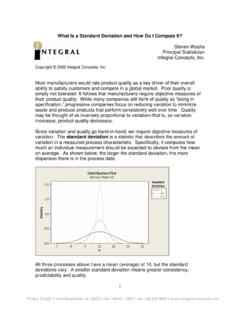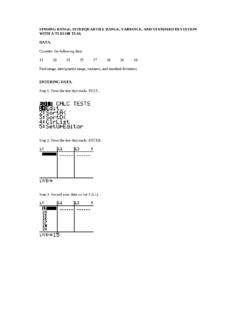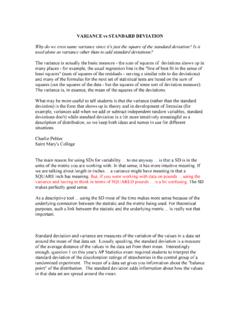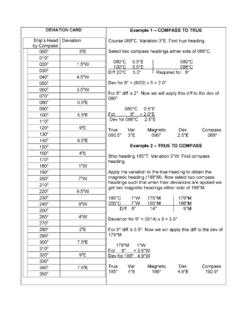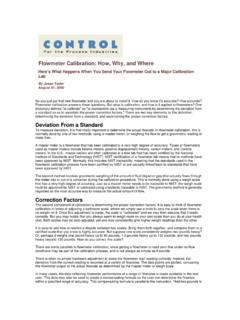Transcription of BIS Working Papers
1 BIS Working Papers No 592. The dollar, bank leverage and the deviation from covered interest parity by Stefan Avdjiev, Wenxin Du, Catherine Koch and Hyun Song Shin Monetary and Economic Department Revised July 2017. JEL classification: F3, G1, G2. Keywords: exchange rates, bank leverage, cross- currency basis BIS Working Papers are written by members of the Monetary and Economic Department of the Bank for International Settlements, and from time to time by other economists, and are published by the Bank. The Papers are on subjects of topical interest and are technical in character. The views expressed in them are those of their authors and not necessarily the views of the BIS. This publication is available on the BIS website ( ). Bank for International Settlements 2017. All rights reserved.
2 Brief excerpts may be reproduced or translated provided the source is stated. ISSN 1020-0959 (print). ISSN 1682-7678 (online). The dollar, bank leverage and the deviation from covered interest parity . Stefan Avdjiev Wenxin Du Bank for International Settlements Federal Reserve Board Cath rine Koch Hyun Song Shin Bank for International Settlements Bank for International Settlements July 2017. Abstract We document the triangular relationship formed by the strength of the US dollar, cross-border bank lending in dollars and deviations from covered interest parity (CIP). A stronger dollar goes hand-in-hand with bigger deviations from CIP and contractions of cross-border bank lending in dollars. Differential sensitivity of CIP. deviations to the strength of the dollar can explain cross-sectional variations in CIP.
3 Arbitrage profits. We argue that underpinning the triangle is the role of the dollar as proxy for the shadow price of bank leverage. Keywords: exchange rates, bank leverage, cross-currency basis JEL Classifications: F3, G1, G2.. We thank Farooq Akram, Fabio Bassi, Claudio Borio, Andrea Buraschi, Krista Hughes, Ralph Koijen, Hanno Lustig, Robert McCauley, Andreas Schrimpf, Vladyslav Sushko, Itay Tuchman, Dimitri Vayanos, Adrien Verdelhan, participants at the FRBNY Conference on Over-the-Counter Derivatives and Recent Regulatory Changes (New York, March 2017), the BIS symposium CIP-RIP? (Basel, May 2017), the LSE's 10th Annual Paul Woolley Conference (London, June 2017), the CEBRA/Boston Fed Boston Policy Workshop (Boston, July 2017) and the NBER Summer Institute (Cambridge, July 2017), as well as seminar participants at the Bank for International Settlements (Basel, February 2017) and the Hong Kong Institute for Monetary Research (Hong Kong, February 2017) for very helpful comments.
4 We gratefully acknowledge the excellent research support of Bat-el Berger. The views expressed in this paper are those of the authors and do not necessarily reflect those of the Bank for International Settlements, the Board of Governors of the Federal Reserve System or any other persons associated with the Federal Reserve System. Any remaining errors are solely our responsibility. 1 Introduction One of the most significant developments in global financial markets in recent years has been the breakdown of covered interest parity (CIP). CIP is perhaps the best-established principle in international finance, and states that the interest rates implicit in foreign exchange swap markets coincide with the corresponding interest rates in cash markets. Otherwise, someone could make a riskless profit by borrowing at the low interest rate and lending at the higher interest rate with currency risk fully hedged.
5 However, the principle broke down during the height of the 2008-2009 crisis. After the Great Financial Crisis (GFC), CIP deviations have persisted and have become more significant recently, especially since mid-2014. Why do such apparent risk-free arbitrage opportunities exist? In competitive mar- kets, market participants are price takers, and can take on any quantity of goods at the prevailing market price. The textbook arbitrage argument is that someone could borrow at the low interest rate and lend out at the higher interest rate, having hedged currency risk completely. The failure of CIP would thereby open up the possibility of unlimited riskless profits. However, in textbooks, there are no banks. In practice, though, such arbitrage typically entails borrowing and lending through banks, and the competitive assumption is violated due to balance sheet constraints that place limits on the size of the exposures that can be taken on by banks.
6 Even for non-banks, their ability to exploit arbitrage opportunities rely on banks to provide leverage. Hence, if deviations from CIP. persist, it must be because banks do not or cannot exploit such opportunities. Our focus, therefore, is on the banking sector, and the ability of banks to take on leverage. The key message of our paper is that the value of the dollar plays the role of a barometer of risk-taking capacity in capital markets. In particular, it is the spot exchange rate of the dollar which plays a crucial role. Deviations from CIP turn on the strength of the dollar; when the dollar strengthens, the deviation from CIP becomes larger. To the extent that CIP deviations turn on the constraints on bank leverage, our results suggest that the strength of the dollar is a key determinant of bank leverage.
7 The cross-currency basis is the difference between the dollar interest rate in the cash 1. Figure 1: dollar broad index and the cross-currency basis 117 20. 104 0. 91 20. 78 40. 2007 2008 2009 2010 2011 2012 2013 2014 2015 2016 2017. FRB broad dollar index (lhs) Mean cross-currency basis swap spread (rhs). market and the implied dollar interest rate from the swap market when swapping foreign currency into dollars. The cross-currency basis measures deviations from the CIP con- dition. Figure 1 plots the broad dollar index (in red), which is the trade-weighted US. dollar exchange rate against its major trading partners. When the red line goes up, the dollar strengthens. The blue line tracks the average cross-currency basis for the ten most liquid currencies vis- -vis the dollar.
8 We see that the cross-currency basis is the mirror image of dollar strength. When the dollar strengthens, the CIP deviations widen. This is especially so in the last 24 months, reflecting the stronger dollar. As we demonstrate in the paper , there is also an asset-pricing relationship underpin- ning these empirical observations. The exposure to the dollar exchange rate is priced in the cross-section of CIP deviations in the sense that variations in CIP deviations across currencies are explained by the sensitivity of the deviations to fluctuations in the broad dollar index. The CIP deviations of different currencies have differing exposures to the dollar factor. Interestingly, we document a reversal of roles. The classical safe haven . currencies, such as the Japanese yen and the Swiss franc, have the highest exposure to the dollar factor, and high-yielding carry currencies, such as the Australian dollar and the New Zealand dollar, have the lowest exposure to the dollar factor.
9 Currencies with higher exposure to the dollar factor exhibit larger CIP deviations and thereby offer greater potential arbitrage profits for banks. Furthermore, the relationship between the level of the basis and the sensitivity to the dollar factor is strongly supported by the event study based on the strong dollar depreciation following the 2016 Presidential Election. 2. One possible explanation for our results is related to the financial channel of exchange rates, through which fluctuations in the strength of the dollar set in motion changes in capital market intermediation spreads that respond at a high frequency. The net exports channel of exchange rate changes is standard in open economy macro models, but the financial channel is less standard, and may operate in the opposite direction to the net exports channel.
10 Under the net exports channel, it is when the domestic currency depreciates that real economic activity picks up. By contrast, the financial channel appears to operate in the opposite direction; it is when the domestic currency appreciates, financial conditions in that country loosen, and CIP deviations narrow. Why do the CIP deviations narrow when the domestic currency strengthens against the dollar? We argue that underpinning this relationship is the role of bank leverage and cross-border bank lending in dollars. Indeed, we will show the existence of a triangle . that coherently ties together (i) the value of the dollar; (ii) the cross-currency basis; and (iii) cross-border bank lending. In this triangle, a depreciation of the dollar is associated with greater borrowing in dollars by non-residents.










